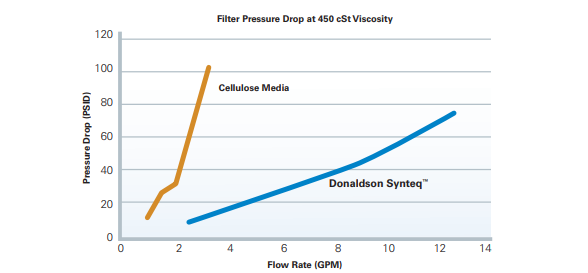By Scott Galloway, Global Sales Manager, Donaldson Company, Inc.
Compressed air is a key power source in industrial facilities. Often called the “fourth utility,” along with water, electricity, and gas, compressed air operates machinery, conveys material, pressurizes hydraulic systems, and performs countless other functions.
All of this requires energy. On average, generating compressed air accounts for 10 to 30 percent of a plant’s electricity costs, according to the U.S. Dept. of Energy.¹ With this sizable impact on costs, facility managers have a keen interest in reducing the energy demands of their compressors, and compressor manufacturers are responding with efforts to design equipment that delivers maximum efficiency. In addition, governments around the globe are legislating higher efficiency requirements for compressed air equipment (see sidebar).
A compressor’s filtration system can have a significant impact on system efficiency. Producing compressed air at a low cost requires three distinct filters to work in harmony, filtering particulates and separating oil mist from the airstream without being too restrictive for air moving through the system. The efficiency of a filter in one location directly impacts the performance of the other two. By applying leading filtration technology throughout the system, compressor manufacturers can support energy conservation—and also help conserve the lubricants required by their equipment.
Here is an introduction to the role of each compressor filter and the technologies that can help optimize system performance.
The Filter Ecosystem: An Overview
Oil-flooded rotary screw air compressors, the most commonly used technology in industry, have three primary filtration components: an inlet air filter, an oil or “lube” filter, and an air-oil separator, as shown in Figure 1.
Figure 1: Schematic of an Oil-Flooded Rotary Screw Air Compressor


The inlet air filter is designed to filter particles with maximum efficiency. The oil filter is designed to capture as much particulate matter as possible in oil. The air-oil separator is designed to separate remaining oil mist before compressed air is released to the system. Together, these three components comprise the filtration ecosystem, as shown in Figure 2.
What Constitutes a High-Quality Inlet Air Filter?
As the first line of filtration defense in maintaining clean air in a compressor system, the air filter’s job is to prevent air-borne particles from entering the compressor with optimal efficiency and minimal restriction. This is typically achieved by some type of fiber-based media housed in a cartridge, as shown in Figure 3.

Inlet air filter media have traditionally been made from cellulose fibers or a cellulose-synthetic blend. More recent technology such as Donaldson’s Ultra-Web® technology uses a fine fiber media made with an electrospinning process that produces a continuous, resilient synthetic fiber ranging from 0.2 to 0.3 microns in diameter. Ultra-Web forms a fine fiber layer with very small inter-fiber spaces that trap dust on the surface of the media, as shown in Figure 4.


Whereas typical traditional cellulose filters provide efficiencies of approximately 99 percent, the fine fiber technology can provide efficiencies of 99.99 percent, as shown in Figure 5.
While cellulose filters can produce efficiencies greater than 99 percent, they also can become unacceptably restrictive for compressor applications due to their tight fiber construction.
Specifically, the fine fiber filters provide high “initial efficiency,” which refers to the efficiency of the air filter element when it is first in use. This keeps particles out of the airstream and extends filter life by capturing dust on the surface of the media, not in the depths of the media. This surface-loading technology has proven to provide low operating pressure drop over an extended period of time, which contributes to a long-lasting filter that requires less energy.
As shown in Figure 6, at airflows of 200 cubic feet per minute (CFM), Ultra-Web filters produced restrictions equivalent to less than 7 inches of water, versus 10 inches for a competing filter.

Improved inlet air filtration also extends life of the downstream filter components -- the lube filter and air-oil separator. Contamination from dust and other particles is the primary factor limiting the life of the lube filter and air-oil separator. By keeping particulates out of the airstream, these other filters can function longer and more efficiently. By reducing downstream contamination and the resulting rise in restriction across the AOS and lube filter, the compressor will require less electricity to deliver a given volume of compressed air, helping to support overall cost of operation.
An example of plugged AOS media is shown in the magnified images of Figure 7. With clean AOS media, 100 percent of the surface area is available for coalescing. With particulate-loaded media, less surface area is available for coalescing, and the AOS becomes less effective.



Lube Filters Keep Oil Clean
Next in line in the filtration ecosystem is the oil filter, or “lube” filter. As oil mixes with air as the air is being compressed, new contaminants are introduced, so the oil filter’s mission is to filter these particulates from the oil. This helps protect the bearings in the airend, as well as preventing particulates from migrating downstream where they can plug the air-oil separator.
Oil filters should be designed with ample dust capacity and efficiency. They are typically housed in canisters somewhat similar in appearance to automotive oil filters, as shown in Figure 8.
Lube filter capacity can be expanded by either increasing the size or by improving the media. Because increasing the filter size often consumes valuable space and results in additional costs, improving the media provides a more-efficient approach.

Donaldson Synteq™ XP media has proven highly effective in compressor lube filters. It provides a uniform media, with more pore openings than cellulose media, which boosts efficiency and capacity. Its proprietary bi-component fibers provide a strong bond, as shown in Figure 9.
Synteq is a resin-free media, which provides lower flow restrictions than standard cellulose media, as shown in Figure 10. It also provides longer life than traditional resin-bonded, cellulose media, while maximizing dirt loading capacity and retention.


Air-Oil Separator: Last Stop
As a last step before air leaves the compressor, the air-oil separator is often the first consideration in an optimized compressor ecosystem. While poorly functioning air filters or oil filters may not be noticed immediately, when air-oil separator performance is compromised, the effects are more obvious. Air exiting the compressor may contain excessive oil mist.
Because the air-oil separator is designed to separate remaining oil mist from the air-oil mixture before air leaves the compressor, its performance is critical to the compressor ecosystem. As with the other filter components, media effectiveness is key to proper performance. Wrapped air-oil separators from Donaldson, as shown in Figure 11, are ideal for most compressor types and come standard with Donaldson’s proprietary Synteq™ media. Pleated air-oil separators are also available from Donaldson, offering additional design flexibility through increased surface area, allowing more airflow.
Donaldson’s premium air-oil separators use the proprietary Synteq XP™ coalescing media to provide longer life than traditional media while maximizing performance. The Synteq media helps meet oil carryover requirements, while maintaining the lowest possible pressure drop, as shown in Figure 12. This “resin-free” media delivers efficient drainage and free air flow, resulting in reduced restriction and by extension, energy savings. In addition to saving energy, delivering low oil carryover keeps the highly engineered and expensive lubricant in the compressor where it belongs. This reduces the volume of make-up oil required, and further reduces the amount of oil downstream in the compressed air system where oil may lead to process issues and customer complaints.

How the Ecosystem Components Work Together
The impacts filtration components have on one another can be seen by observing the effect air filters have on air-oil separator life. As shown in Figure 13, Ultra-Web air filters produced a slower rise in restriction across air-oil separators compared to air filters with cellulose media, more than doubling the life of the air-oil separator in one case and increasing by approximately 65 percent in another case. These results are from two separate 600-HP compressors in a North Carolina textile plant. Donaldson performed baseline testing with freshly serviced machines using the original equipment cellulose elements (red lines), then serviced the compressors again with fresh oil and AOS, and replaced the air elements with Ultra-Web versions and tested again. Longer AOS life in these compressors was the result (blue lines).


Ultimately, pressure drop robs compressors of efficiency. The same amount of electricity produces less compressed air when pressure drops are introduced. The basic rule of thumb is that a 1-psi pressure drop essentially robs the compressor of 0.5 percent of brake horsepower, as shown in Figure 14. For example, a rise in pressure drop of only 3 psi across an air-oil separator in a 200-HP unit can increase costs by up to $1,460 per year, in some cases.
Air-Oil Separation
Rule of Thumb:
1 PSI ΔP = 0.5% HP

| $/Yr = Cost per Year | $97,329 |
| BHP = Brake Horsepower | 200 |
| $/kwhr = Electricity Cost per Kilowatt Hour | 0.07 |
| m.e. = Motor Efficiency | 0.94 |
| hrs/yr = Operational Hours of the Compressor | 8760 |
3 PSI of added pressure drop across the AOS - $1,460/yr
Conclusion
Applying the ecosystem approach to compressors, it becomes clear that the system is only as good as its “weakest link”. If compromises are made in one filtration component, it can adversely affect the other components and ultimately the entire system. Because compressor oils are highly engineered oils, and more expensive than standard lubricants, compressor system owners have compelling reasons to minimize losses and maximize efficiency. Increased efficiency supports cost savings and fewer headaches for plant operators/owners. With Donaldson’s technology and engineering support, compressor owners can find an ecosystem-based product solution that properly match filtration components to help them optimize efficiency.
Compressor Efficiency Regulations
Improvements in compressor efficiency are becoming more crucial to plant owners due to recent changes in regulations. In December 2016, the US Department of Energy (DOE) released energy efficiency standards for rotary air compressors. The DOE estimates that compressors meeting the new standards will save 0.16 quadrillion BTUs by compressors sold over 30 years, or about 15.6 billion kilowatt hours, resulting in net savings of $200 to $400 million for compressors purchased over this period. This reduction in energy consumption will also prevent the emission of an estimated 8.2 million metric tons of CO2 over the same period.
The Canadian Standards Association also released a document geared toward improved measurement of compressor performance (C837-16 “Monitoring and Energy Performance of Compressed Air Systems”). The standard specifies information to be gathered and how system parameters like power, energy, flow, pressure, and production output are to be measured or calculated using uniform, validated, and repeatable methods of measurement. It provides guidance in defining methodologies for establishing energy performance indicators and energy baselines to be used as part of an overall energy management system. For compressed air systems, specific requirements outlining a consistent methodology for measuring, estimating, and reporting the energy performance are provided.
The European Union has published eco design directives, with requirements pending. The directive state this: "Action should be taken during the design phase of energy-related products, since it appears that the pollution caused during a product’s life cycle is determined at that stage, and most of the costs involved are committed then…Greenhouse gas mitigation through increased energy efficiency should be considered a priority environmental goal pending the adoption of a working plan.” - Integrated Product Policy: Building on Environmental Life-Cycle Thinking (Journal of the European Union).


